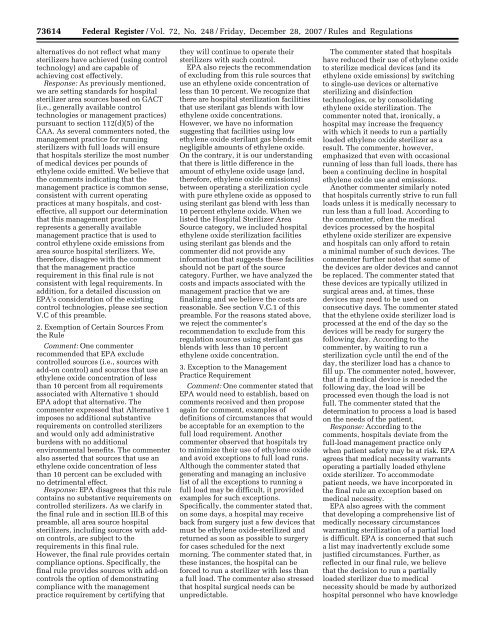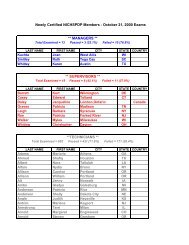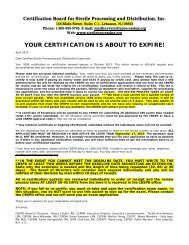Hospitals: Ethylene Oxide Sterilizers - US Environmental Protection ...
Hospitals: Ethylene Oxide Sterilizers - US Environmental Protection ...
Hospitals: Ethylene Oxide Sterilizers - US Environmental Protection ...
You also want an ePaper? Increase the reach of your titles
YUMPU automatically turns print PDFs into web optimized ePapers that Google loves.
73614 Federal Register / Vol. 72, No. 248 / Friday, December 28, 2007 / Rules and Regulationspwalker on PROD1PC71 with RULESalternatives do not reflect what manysterilizers have achieved (using controltechnology) and are capable ofachieving cost effectively.Response: As previously mentioned,we are setting standards for hospitalsterilizer area sources based on GACT(i.e., generally available controltechnologies or management practices)pursuant to section 112(d)(5) of theCAA. As several commenters noted, themanagement practice for runningsterilizers with full loads will ensurethat hospitals sterilize the most numberof medical devices per pounds ofethylene oxide emitted. We believe thatthe comments indicating that themanagement practice is common sense,consistent with current operatingpractices at many hospitals, and costeffective,all support our determinationthat this management practicerepresents a generally availablemanagement practice that is used tocontrol ethylene oxide emissions fromarea source hospital sterilizers. We,therefore, disagree with the commentthat the management practicerequirement in this final rule is notconsistent with legal requirements. Inaddition, for a detailed discussion onEPA’s consideration of the existingcontrol technologies, please see sectionV.C of this preamble.2. Exemption of Certain Sources Fromthe RuleComment: One commenterrecommended that EPA excludecontrolled sources (i.e., sources withadd-on control) and sources that use anethylene oxide concentration of lessthan 10 percent from all requirementsassociated with Alternative 1 shouldEPA adopt that alternative. Thecommenter expressed that Alternative 1imposes no additional substantiverequirements on controlled sterilizersand would only add administrativeburdens with no additionalenvironmental benefits. The commenteralso asserted that sources that use anethylene oxide concentration of lessthan 10 percent can be excluded withno detrimental effect.Response: EPA disagrees that this rulecontains no substantive requirements oncontrolled sterilizers. As we clarify inthe final rule and in section III.B of thispreamble, all area source hospitalsterilizers, including sources with addoncontrols, are subject to therequirements in this final rule.However, the final rule provides certaincompliance options. Specifically, thefinal rule provides sources with add-oncontrols the option of demonstratingcompliance with the managementpractice requirement by certifying thatthey will continue to operate theirsterilizers with such control.EPA also rejects the recommendationof excluding from this rule sources thatuse an ethylene oxide concentration ofless than 10 percent. We recognize thatthere are hospital sterilization facilitiesthat use sterilant gas blends with lowethylene oxide concentrations.However, we have no informationsuggesting that facilities using lowethylene oxide sterilant gas blends emitnegligible amounts of ethylene oxide.On the contrary, it is our understandingthat there is little difference in theamount of ethylene oxide usage (and,therefore, ethylene oxide emissions)between operating a sterilization cyclewith pure ethylene oxide as opposed tousing sterilant gas blend with less than10 percent ethylene oxide. When welisted the Hospital Sterilizer AreaSource category, we included hospitalethylene oxide sterilization facilitiesusing sterilant gas blends and thecommenter did not provide anyinformation that suggests these facilitiesshould not be part of the sourcecategory. Further, we have analyzed thecosts and impacts associated with themanagement practice that we arefinalizing and we believe the costs arereasonable. See section V.C.1 of thispreamble. For the reasons stated above,we reject the commenter’srecommendation to exclude from thisregulation sources using sterilant gasblends with less than 10 percentethylene oxide concentration.3. Exception to the ManagementPractice RequirementComment: One commenter stated thatEPA would need to establish, based oncomments received and then proposeagain for comment, examples ofdefinitions of circumstances that wouldbe acceptable for an exemption to thefull load requirement. Anothercommenter observed that hospitals tryto minimize their use of ethylene oxideand avoid exceptions to full load runs.Although the commenter stated thatgenerating and managing an inclusivelist of all the exceptions to running afull load may be difficult, it providedexamples for such exceptions.Specifically, the commenter stated that,on some days, a hospital may receiveback from surgery just a few devices thatmust be ethylene oxide-sterilized andreturned as soon as possible to surgeryfor cases scheduled for the nextmorning. The commenter stated that, inthese instances, the hospital can beforced to run a sterilizer with less thana full load. The commenter also stressedthat hospital surgical needs can beunpredictable.VerDate Aug2005 23:53 Dec 27, 2007 Jkt 214001 PO 00000 Frm 00042 Fmt 4700 Sfmt 4700 E:\FR\FM\28DER1.SGM 28DER1The commenter stated that hospitalshave reduced their use of ethylene oxideto sterilize medical devices (and itsethylene oxide emissions) by switchingto single-use devices or alternativesterilizing and disinfectiontechnologies, or by consolidatingethylene oxide sterilization. Thecommenter noted that, ironically, ahospital may increase the frequencywith which it needs to run a partiallyloaded ethylene oxide sterilizer as aresult. The commenter, however,emphasized that even with occasionalrunning of less than full loads, there hasbeen a continuing decline in hospitalethylene oxide use and emissions.Another commenter similarly notedthat hospitals currently strive to run fullloads unless it is medically necessary torun less than a full load. According tothe commenter, often the medicaldevices processed by the hospitalethylene oxide sterilizer are expensiveand hospitals can only afford to retaina minimal number of such devices. Thecommenter further noted that some ofthe devices are older devices and cannotbe replaced. The commenter stated thatthese devices are typically utilized insurgical areas and, at times, thesedevices may need to be used onconsecutive days. The commenter statedthat the ethylene oxide sterilizer load isprocessed at the end of the day so thedevices will be ready for surgery thefollowing day. According to thecommenter, by waiting to run asterilization cycle until the end of theday, the sterilizer load has a chance tofill up. The commenter noted, however,that if a medical device is needed thefollowing day, the load will beprocessed even though the load is notfull. The commenter stated that thedetermination to process a load is basedon the needs of the patient.Response: According to thecomments, hospitals deviate from thefull-load management practice onlywhen patient safety may be at risk. EPAagrees that medical necessity warrantsoperating a partially loaded ethyleneoxide sterilizer. To accommodatepatient needs, we have incorporated inthe final rule an exception based onmedical necessity.EPA also agrees with the commentthat developing a comprehensive list ofmedically necessary circumstanceswarranting sterilization of a partial loadis difficult. EPA is concerned that sucha list may inadvertently exclude somejustified circumstances. Further, asreflected in our final rule, we believethat the decision to run a partiallyloaded sterilizer due to medicalnecessity should be made by authorizedhospital personnel who have knowledge
















